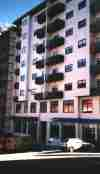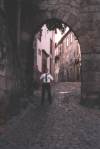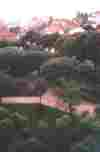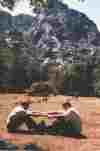|
|
|
Guarda is a pleasant health resort and the highest town in Portugal at an altitude of 3281 feet above sea level. The town is situtated on the northeaster slopes of the Serra da Estrela, the highest mountain in Portugal. Consequently, Guarda is very cold in the winter. Snow is common. The surrounding area is very hot and dry in the summer. It´s name means "protector." It was once one of the main strongholds on the border with Spain. The castle in Guarda was one of a chain of defensive fortifications along this boarder, the older boarder in Europe. In recent years a modern town has grown dramatically around the medieval city.
|
|
|
The site of Guarda served as a military base for Julius Ceasar (so it is believed) before giving support to the Roman town of Lancia Oppidana. It later served as a fortress for the Visigoths before being overwhelmed by the Moors. The town was recaptured from the Moors by Afonso Henriques, the first king of Portugal. In that era the town was enlarged and fortified by the succeding Kings, Dom Sancho I and Dom Dinis I. However, during the French invasion in 1808, Guarda was not able protect Portugal.
|
|
|
Source: Michelin Guide book for Portugal
|
|

|
The Guarda branch moved into a new chapel in 1998. While much smaller the new chapel is much brigher and warmer. The branch occupies two suites on the second floor. See just above the van in the picture . Office and a class room are on this side with the Sacrament room on the other side. Photo by Ryan Angus.
|
|
|
A view of the roof tops of Guarda. This view is so typical of Portugal, with orange tile roofs, rock and whitewashed walls. Picture by Ryan Angus.
|

|
|

|
This is an archway from the old town of Guarda. Note the stones in the arch and of the pavement. The Portuguese took advantage of the abundance of granite in their construction. Photo by Ryan Angus.
|
|
|
This is a picture of the Sé or Old Cathedral in Guarda. The Sé was begun in 1390 in the gothic style, but as it was completed in 1540, Renaissance and Manueline elements are clearly visible. That is, it is much more flowery and ornate like a ginger bread house. The granite edifice is crowned with pinnacles and trefoils. Photo by Ryan Angus.
|

|
|

|
The Guarda chapel until 1998 was in the basement and behind an apartment building. This pictures shows the elders at the entrance to the chapel. This chapel was one of the coldest, most difficult to find, and (ironically) one of the largest in the mission.
|
|
|
This is a view of one of the pracas in Guarda. Like all of Portugal, the public spaces are often well manicured and peaceful. Photo by Ryan Angus.
|

|
|

|
South of Guarda before you reach Covilhã, are the remains of a Roman Inn. There are many remanents of Roman habitation throughout Portugal and the Iberian Pennisula. Photo by Ryan Angus.
|
|
|
High on the highest mountain in Portugal, the Serra da Estrela, is a broad canyon that has been made into a lovely and inspiring picnicking area. The high mountain air inspire Elders Smith and Johnson into a stick pulling contest. Photo by Ryan Angus.
|

|
|

